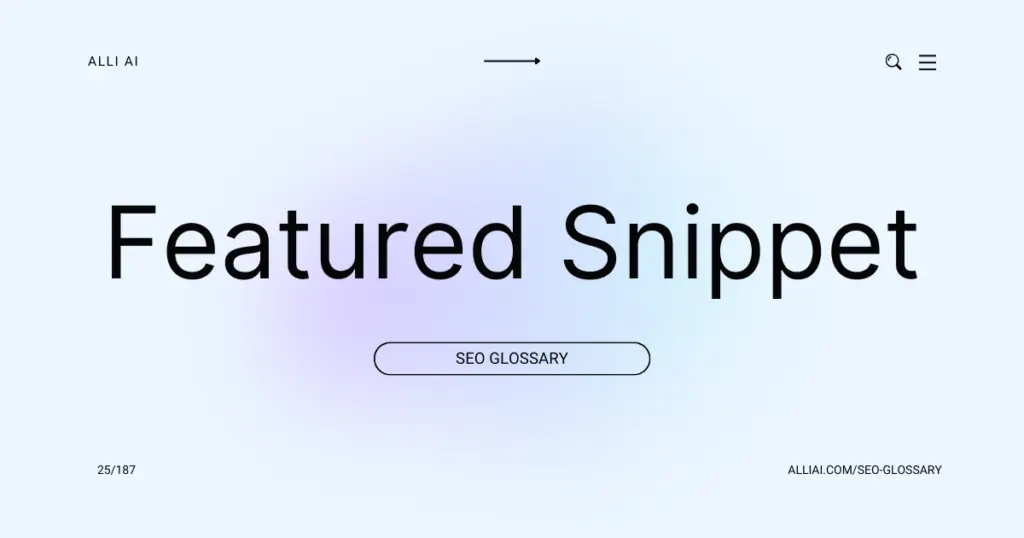What Does Featured Snippet (Position Zero) Mean?
A Featured Snippet, often called Position Zero, is a special box that appears at the top of Google search results. It provides a quick answer or summary to a user’s question, pulled from a website. This box includes a snippet of content, typically a few sentences or a list, and sometimes an image. The content is meant to directly answer the search query without requiring the user to click through to a website, although a link to the source is provided.
Where Does Featured Snippet (Position Zero) Fit Into The Broader SEO Landscape?
Featured Snippets, often known as Position Zero, are short snippets of text that appear at the top of Google’s search results in response to a query. They are designed to answer the user’s question quickly and efficiently without requiring them to click through to a webpage. This prime spot is highly coveted as it increases visibility and click-through rates.
From an SEO perspective, owning the Featured Snippet for relevant queries can significantly boost a website’s traffic, establish credibility, and enhance brand recognition. They are particularly valuable for voice searches and mobile queries where immediate, concise answers are favored.
To optimize for Featured Snippets, websites should provide clear, authoritative answers to commonly asked questions. Structuring content with headers, lists, tables, and concise paragraphs can enhance a site’s chances of being selected for this position. SEO strategies should also focus on high-quality content that directly addresses user intent, leveraging the proper keywords and phrases that align with what users are asking in their search queries.
Overall, Featured Snippets form an integral part of SEO strategies focused on improving organic search visibility, driving traffic, and positioning a brand as an industry leader.
Real Life Analogies or Metaphors to Explain Featured Snippet (Position Zero)
1. Treasure Map: Imagine you’re using a treasure map to find buried gold. Featured snippets are like the big, bold “X” on the map, telling you exactly where to dig to find the treasure without having to explore the entire island.
2. Movie Trailer: Featured snippets act like a movie trailer, giving you the best scenes and the plot’s essence without watching the whole film. It’s designed to satisfy your immediate curiosity and entice you further.
3. Nutshell: Consider a nutshell holding a concise summary of a large, detailed story. The featured snippet is like this nutshell, offering a condensed version of the information without opening the entire “nut.”
4. Elevator Pitch: Just as an elevator pitch gives you a quick, persuasive preview of an idea within seconds, a featured snippet provides a succinct answer or description from a longer content piece, all while you’re still on the search page.
5. Highlight Reel: Like a sports highlight reel that shows the most exciting or important moments of a game quickly, a featured snippet displays the key information from a webpage that might be most useful for your query.
How the Featured Snippet (Position Zero) Functions or is Implemented?
1. Query Processing: When a user types a query into Google, the algorithm first interprets the intent of the search, distinguishing between informational, transactional, or navigational purposes.
2. Content Crawling and Indexing: Google’s bots crawl the web to find and index content that closely matches the user’s query, based on relevance and authority.
3. Featured Snippet Eligibility: Among the indexed pages, content that is well-structured and clearly answers questions (such as definitions, how-to guides, lists, prices) is evaluated for snippet eligibility.
4. Extraction and Ranking: The algorithm extracts potentially relevant snippets from eligible content sources. It evaluates these snippets based on factors like accuracy, conciseness, page authority, and user engagement.
5. Snippet Display: The selected snippet is displayed at the top of the search results page, above the first organic result, often formatted to highlight the answer to the user’s question (paragraph, list, table).
6. User Feedback Loop: User interactions with the snippet (click-through rate, bounce rate) are monitored to assess satisfaction and relevance, influencing future snippet selection and adjustment.
Impact Featured Snippet (Position Zero) has on SEO
Featured Snippets, occupying Position Zero in search results, significantly boost a website’s visibility, often placing content at the very top of the search page above traditional listings. This premier positioning can lead to a substantial increase in click-through rates (CTR), as snippets provide immediate answers or summaries directly in the results, making them highly attractive and accessible to users.
By effectively owning Position Zero, a website can establish authority and credibility in its niche. As snippets often provide direct answers to users’ queries, they inherently enhance user experience by offering quick, relevant information without the necessity of clicking through multiple pages. This can be especially beneficial for voice search and mobile users, who favor rapid responses.
Moreover, landing a Featured Snippet can indirectly improve the rankings of a website’s other pages by increasing overall site traffic and engagement. As users grow to trust the authority of a site that repeatedly provides valuable and succinct answers, they are more likely to return or explore additional content on the site. However, it’s crucial to note that while Featured Snippets can direct a large amount of traffic, they might reduce the number of visitors to a website if users get all the information they need directly from the snippet without clicking through.
Overall, while Featured Snippets can significantly enhance visibility and user engagement, their impact on direct site traffic can vary depending on the nature of the query and the user’s needs.
SEO Best Practices For Featured Snippet (Position Zero)
1. Identify target keywords where featured snippets already appear by using SEO tools like Ahrefs, SEMrush, or Google Search Console.
2. Analyze the format of existing featured snippets for those keywords (paragraph, list, table).
3. Create content specifically designed to answer questions related to the target keyword. It should be precise, direct, and contained within an appropriate HTML tag (p, ul, ol, table).
4. Structure your content with clear headings (H1, H2, H3) for easy scanning by Google’s algorithms.
5. Include the target question as a heading and follow immediately with a concise, straightforward answer (40-60 words for paragraph snippets).
6. Utilize lists and tables if the target featured snippet is in these formats, ensuring they are well-organized and formatted correctly in HTML.
7. Optimize the overall page for SEO best practices, including title tags, meta descriptions, and URL structures that incorporate the target keyword.
8. Enhance content comprehensiveness surrounding the snippet with in-depth information, employing related keywords and semantic variations.
9. Implement schema markup where applicable to define your content more clearly to search engines.
10. Regularly update your content to keep it fresh and relevant as search trends and information evolve.
11. Promote your content across social media and other channels to increase traffic and engagement rates.
12. Monitor your page’s performance in SERPs and adjust content as needed if not initially selected for the snippet or if Google adjusts its snippet selection.
Common Mistakes To Avoid
1. Targeting Irrelevant Queries: Optimizing for snippets that aren’t relevant to your business or audience can attract the wrong traffic, increasing bounce rates.
*Solution*: Research keywords thoroughly to ensure they align with your business’s core offerings and audience intent.
2. Poor Content Quality: Google prefers concise, well-structured, factual, and directly informative content for featured snippets.
*Solution*: Ensure content is well-written, fact-checked, and structured with clear headings, lists, and paragraphs.
3. Lack of Proper Formatting: Featured snippets often favor content that is easy to parse visually, such as lists, tables, and bullet points.
*Solution*: Use proper HTML structure with headers and lists, and organize content in a format that directly addresses potential queries.
4. Neglecting Question-Based Content: Most featured snippets are triggered by question-based searches.
*Solution*: Incorporate direct questions and answers in your content; use tools like “Also Asked” for insight into relevant questions.
5. Ignoring Voice Search: As voice search grows, optimizing for it becomes crucial since it heavily uses featured snippets for answers.
*Solution*: Incorporate natural language and direct answers in your content and consider the implications of conversational voice queries.
6. Not Updating Content: Old or outdated information can lose out to more current content for a featured snippet.
*Solution*: Regularly update your information, especially on fast-evolving topics, to maintain accuracy and relevance.
7. Over-Optimization: Excessively structuring content specifically to gain featured snippets can make it less engaging or readable.
*Solution*: Maintain a balance between technical SEO and natural, engaging writing to ensure content benefits users first.
By focusing on these areas, the approach remains tailored and avoids the common pitfalls that might otherwise jeopardize your content’s chances of being showcased as a featured snippet.






